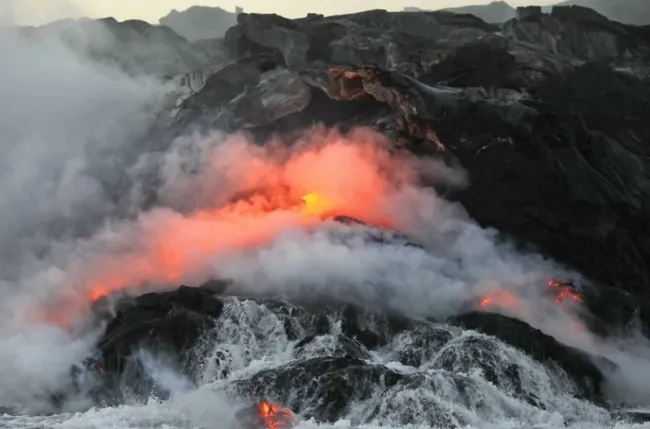
Hawaii Volcanoes National Park, located on the Big Island of Hawaii, is a unique destination that showcases the active geological processes shaping the island. The park is home to two of the world’s most active volcanoes, Kīlauea and Mauna Loa. Visitors can witness live volcanic activity, walk through lava tubes, and explore a variety of ecosystems ranging from tropical rainforests to arid deserts. The park's dramatic landscape and cultural significance make it one of Hawaii’s most visited attractions.
History of the Park
Established in 1916, Hawaii Volcanoes National Park is one of the oldest national parks in the United States. The park’s formation was driven by the recognition of the need to protect Hawaii's volcanic landscapes and natural beauty. Kīlauea has been a sacred site for Native Hawaiians for centuries, and the park preserves numerous cultural and archaeological sites. Over the years, the park has seen significant volcanic eruptions, some of which have drastically altered the landscape. In 1987, the park was designated a UNESCO World Heritage Site.
Main Features
The main draw of Hawaii Volcanoes National Park is its volcanic features, particularly the Kīlauea Caldera and the Halemaʻumaʻu Crater. Visitors can often see glowing lava flows and steam vents, providing a rare opportunity to witness the Earth’s dynamic forces. Other highlights include the Thurston Lava Tube, where visitors can walk through a tunnel formed by flowing lava, and the Chain of Craters Road, which offers scenic views of the park's volcanic features and ends at a point where lava has flowed over the road.
The park also features diverse ecosystems that include rainforests, deserts, and coastal areas, offering opportunities to explore various habitats and native species.
Types of Trails
Hawaii Volcanoes National Park offers a range of trails for all skill levels. Popular trails include:
- Kīlauea Iki Trail: A moderate 4-mile loop that descends into a former lava lake, providing close-up views of the cooled, cracked surface and steam vents.
- Devastation Trail: An easy 1-mile walk through a landscape that was buried by a 1959 eruption, offering a stark contrast between volcanic ash and resilient plants.
- Crater Rim Trail: A more challenging 11-mile trail that encircles the Kīlauea Caldera, offering breathtaking views of the volcanic landscape.
- Nāhuku (Thurston Lava Tube): A short and easy trail leading through a lush rainforest and into an ancient lava tube.
Crowd Expectations and Annual Visitors
Hawaii Volcanoes National Park is a popular destination, attracting over 1.1 million visitors annually. The park experiences its peak visitation during the summer months and around major holidays, so visitors may encounter crowds, especially at popular sites such as the Kīlauea Overlook and the Thurston Lava Tube. Early mornings and weekdays tend to be quieter, offering a more peaceful experience.
Accessibility for Seniors
The park offers several amenities and accommodations to make it accessible for senior visitors. Many of the park’s attractions, such as the Jaggar Museum Overlook, Nāhuku (Thurston Lava Tube), and some sections of the Crater Rim Trail, are easily accessible by vehicle and involve minimal walking. The park's visitor center provides information and resources to help seniors plan their visit, and ranger-led programs are available that cater to various mobility levels.
Accessibility for Wheelchairs
Hawaii Volcanoes National Park is committed to providing accessibility for all visitors. The Kīlauea Visitor Center, Jaggar Museum, and Volcano House are all wheelchair accessible. There are also accessible trails, including the paved sections of the Crater Rim Trail, Devastation Trail, and the Volcano Art Center. Wheelchair-accessible restrooms and parking are available at multiple locations throughout the park.
Park Amenities
The park offers a wide range of amenities, including the Kīlauea Visitor Center, which features exhibits, maps, and information on the park's history and geology. The Jaggar Museum, located near the summit of Kīlauea, provides educational displays about volcanology. Dining options are available at the Volcano House, a historic hotel located within the park, which also features a gift shop.
Camping Facilities
There are two main campgrounds in the park: Nāmakanipaio Campground and Kulanaokuaiki Campground. Nāmakanipaio offers tent camping with access to restrooms and picnic tables, while Kulanaokuaiki is a more primitive option with no water or restrooms. Backcountry camping is also available with a permit, allowing visitors to experience the park's remote wilderness areas.
Access to Lodging
The Volcano House, a historic hotel within the park, provides comfortable accommodations with stunning views of the Kīlauea Caldera. Additionally, there are various bed-and-breakfasts and vacation rentals available in the nearby town of Volcano, just outside the park entrance.
Pet-Friendliness
Hawaii Volcanoes National Park has specific guidelines for visitors with pets. Pets are allowed in certain areas, including parking areas, roadways, and designated campgrounds, but they must be leashed at all times. Pets are not permitted on trails or in wilderness areas to protect the park’s fragile ecosystems and native wildlife.
Best Months to Visit
The best time to visit Hawaii Volcanoes National Park is during the spring (March to May) or fall (September to November) when the weather is pleasant, and the crowds are smaller. Summer is also a popular time to visit, but it can be more crowded. The park is open year-round, and volcanic activity can be observed at any time, making it a fascinating destination no matter the season.
Conclusion
Hawaii Volcanoes National Park offers an unparalleled opportunity to witness the raw power of volcanic activity while exploring the diverse landscapes and ecosystems of the Big Island. Whether you’re hiking through ancient lava fields, exploring a lava tube, or watching an active eruption, the park provides a unique and unforgettable experience. With accessible trails, camping options, and various amenities, the park is an ideal destination for nature lovers and adventure seekers alike.



